Zero-waste Restaurant Phuket- Jaras, A Michelin Guide Restaurant
Words: Joanna Florento
Photos: Monica Tindall
Jaras restaurant in Phuket is Thai fine dining with soul, transforming hyper-local and often overlooked ingredients into a graceful, sustainable culinary experience. It’s where elegance meets ecology—without missing a beat of flavour.
At Jaras, everything begins with balance. In a world that is focused on optimisation and efficiency – often at the expense of natural resources – Jaras compels us to pause, return to our roots, and find beauty in unexpected places. By incorporating local ingredients that are overabundant in nature into an exquisite fine dining experience, Jaras brings things full circle with sophistication and intention.
Zero-waste Restaurant Phuket – Jaras
We are greeted warmly by Jaras’ Supervisor, Jessica, who guides us to the far wall to explain the restaurant’s ethos and show us some examples of the ingredients featured in our nine-course Taste of Jaras menu. Everywhere we look, the spotlight is on natural ingredients that are sourced locally and farmed sustainably. Jaras maintains a partnership with Katian Farm and local fishermen within the region to support the Phuket community and homegrown sustainable practices.
As we gain a deeper understanding of the kitchen’s ethos, we sip a welcome drink made from fermented lemon peels and the second cut of lemon—ingredients once considered waste, now given a second life in the glass.
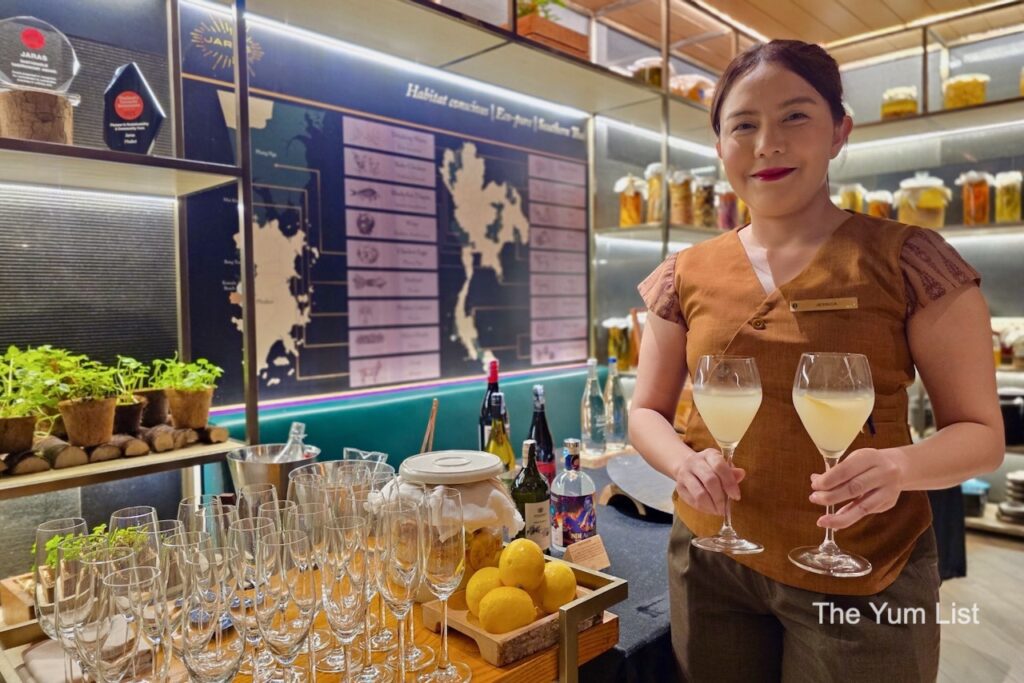
We pause to greet Chef Nui, Sous Chef Kiattichai, and the team working gracefully in the open kitchen before continuing our walk through the warmly lit space. Along the way, we pass wall panels crafted from pine trees once cleared to build the restaurant—now thoughtfully repurposed as part of the décor. Our table awaits, bathed in a soft, rosy glow. At Jaras, the commitment to sustainability goes well beyond the menu. We admire plates made from broken tableware and crushed eggshells, and menus delicately printed on recycled lemongrass paper.
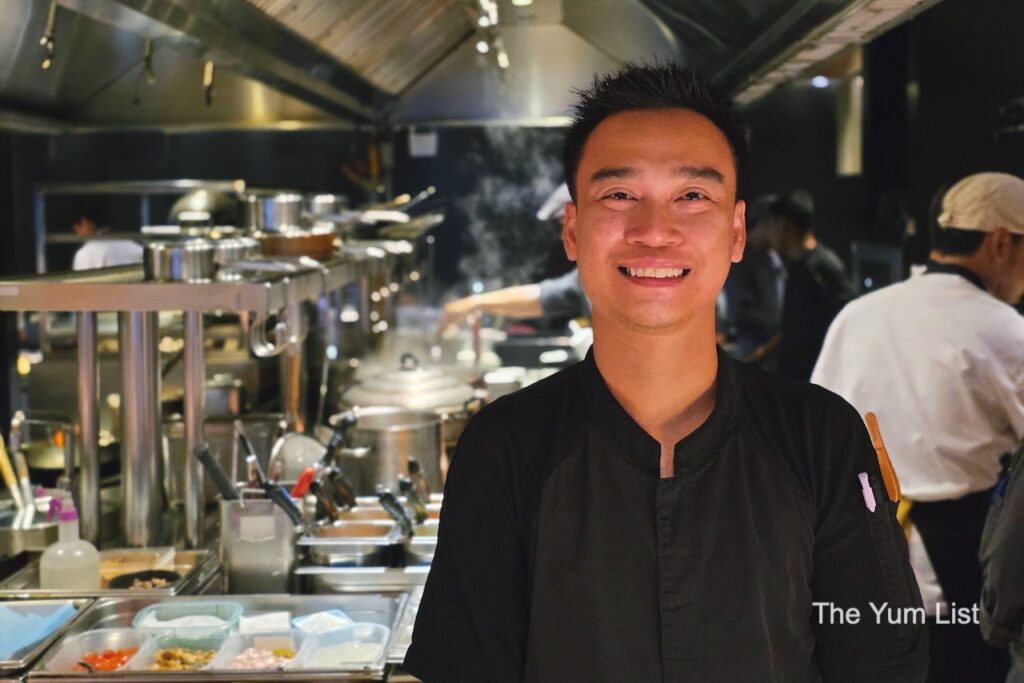
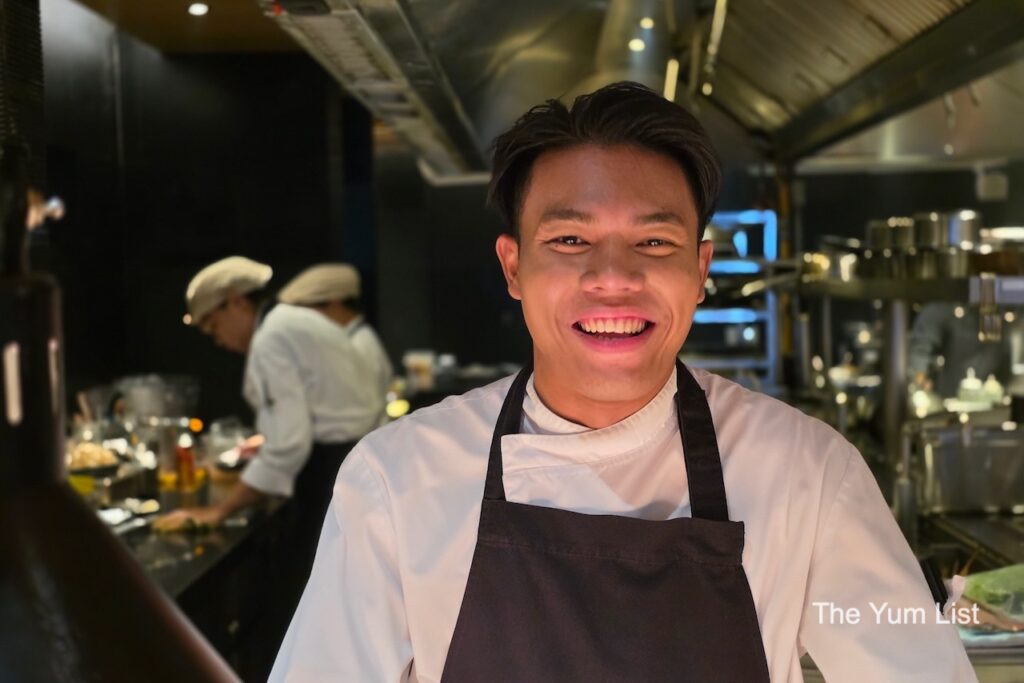
Taste of Jaras Menu
The Taste of Jaras menu is priced at THB 3,650++ per person. Beverage pairing options include a Thai pairing (wine and cocktail) for THB 2,190++, a wine pairing for THB 2,790++, or a non-alcoholic soft pairing for THB 1,350++ per person.
We opt for the wine pairing — an intriguing selection that reflects the kitchen’s ethos, featuring sustainable, organic, and largely natural wines. Full disclosure: natural wines can be divisive. If they’re not to your taste, Jaras offers an extensive wine list, so you’re welcome to curate your own experience.
Amuse-bouche
We’re instantly intrigued by the welcome snack—a dainty parcel of crispy rice, corn powder, mushroom, and prawn powder encased in a translucent, edible bag made from corn flour. Meant to mimic plastic, it dissolves delicately on the tongue, giving way to a few crunchy, savoury bites.

Then comes the amuse-bouche trio—and we’re not just amused, we’re floored. Each bite-sized course is seamlessly integrated into its natural presentation, featuring wild herbs, floating pennywort, snails, and even an entire horseshoe crab.
We begin with the moo hong thod — spring rolls of organic pork belly tucked into delicate cones, speared upright in a pot brimming with floating pennywort. It’s Phuket street food reimagined.
Next, the laab hoi cherry, or apple snail, arrives nestled in its shell with Thai mint and edible flowers. Considered invasive in Northern Thailand for its fondness for rice, here it takes centre stage. Chewy and tangy with a bold zip of spice, it’s both surprising and satisfying.
Finally, miniature tarts are perched atop an upturned horseshoe crab. Filled with spicy herbs, sour mango, and edible blooms, each bite bursts with vibrant, fiery flavour. A closer look reveals a prized local delicacy — horseshoe crab roe (yum kai meng da) — garnishing the top. Sensing the heat building, Jessica hands me a glass of chilled mango juice, a sweet balm against the spice.
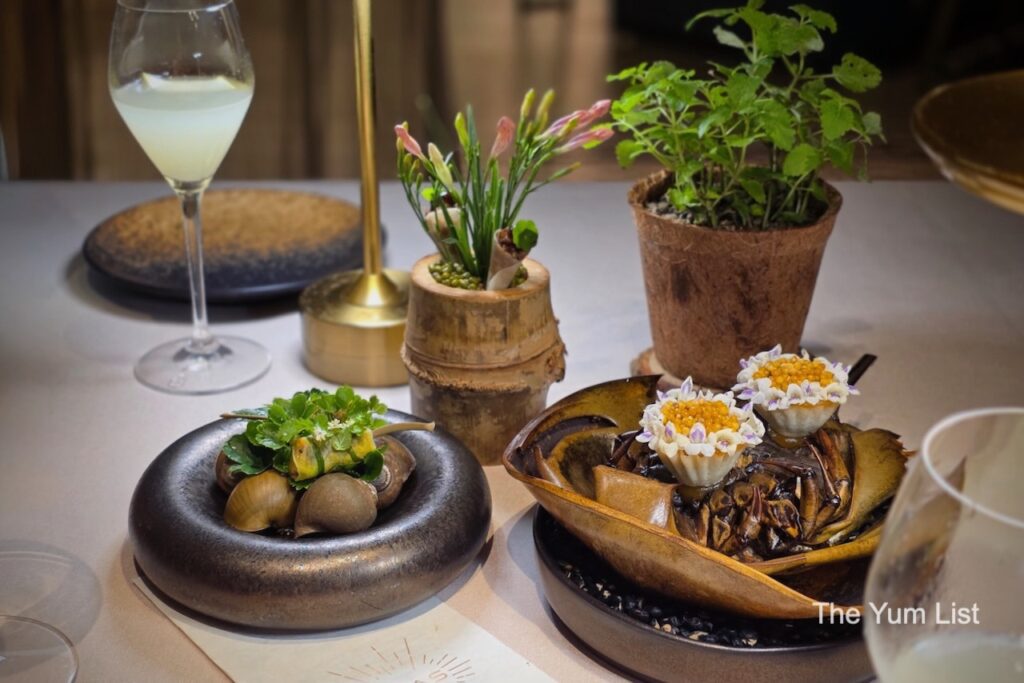
To accompany the opening bites, we’re each poured a glass of Odinstal Riesling 120 N.N., 2021. With delicate notes of white peach, citrus blossom and wild herbs, this biodynamic German white brings just the right lift and freshness to match the vibrant, spice-laced amuse-bouches.
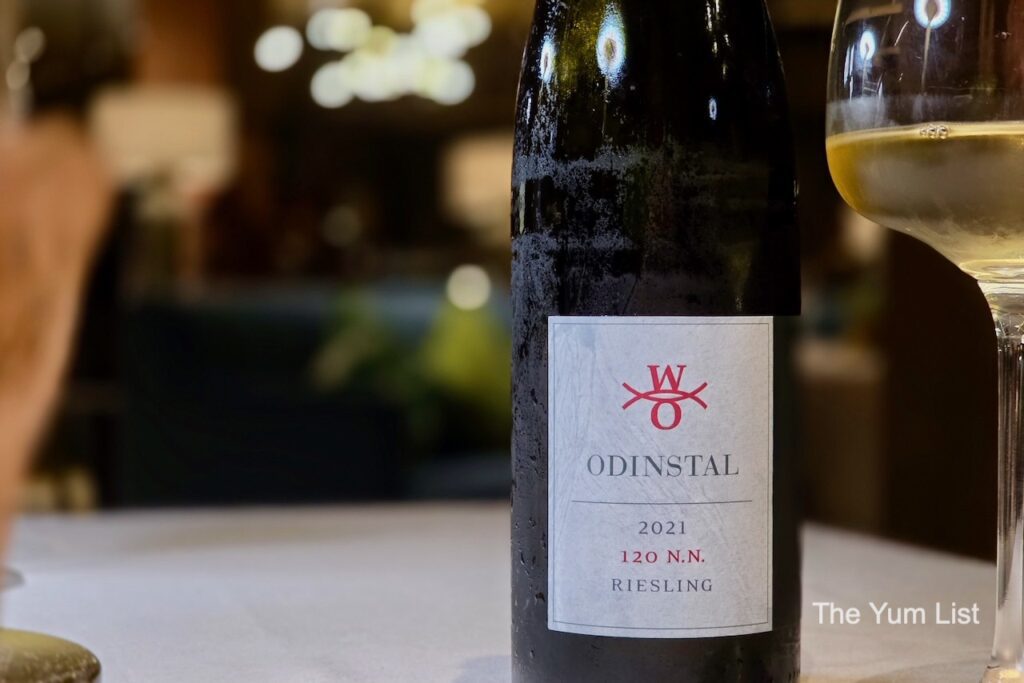
Trio Meuk Nam Dum
We tuck into our meal with the Trio Meuk Nam Dum, featuring squid tart filled with house-made crispy squid and squid ink sauce. The squid is sourced from the Andaman Sea. It’s the second cut after being marinated in charcoal water overnight and stir-fried with squid ink sauce. Water mimosa, long considered an invasive species by local fishermen due to its propensity to block local boat paths and compete with fish for oxygen, is incorporated into a flavourful salad. We polish this dish off quickly, savouring each warm, inky, and slightly chewy bite.
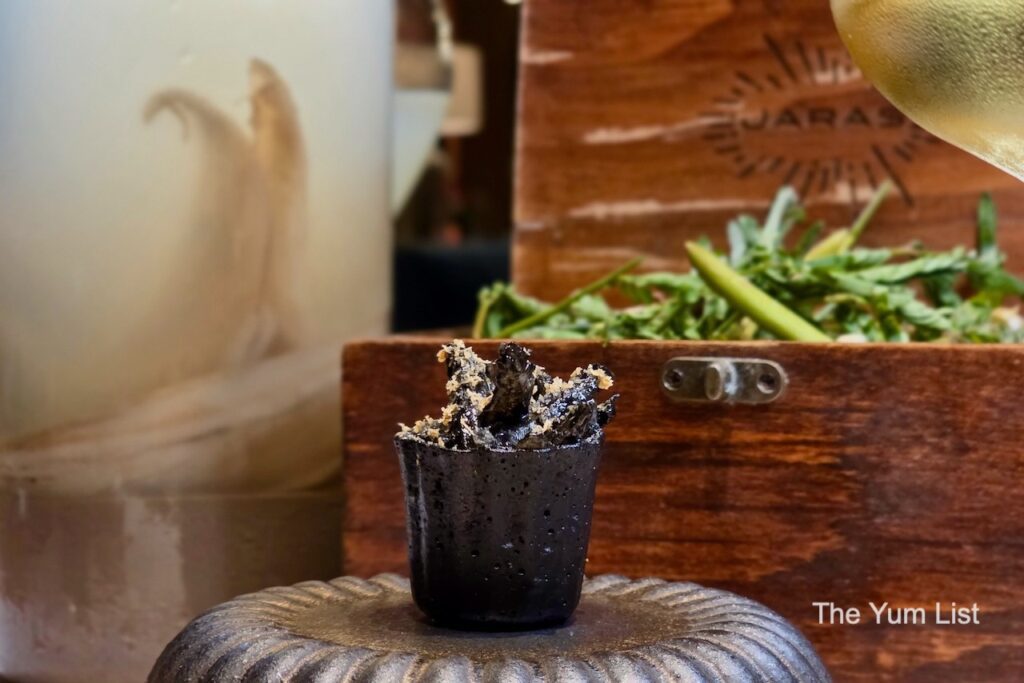
Gai Thod
The Gai Thod makes a smooth entrance, plated simply but invitingly on a small leaf and finished with a drizzle of sauce. This is no ordinary chicken wing—it’s organic Tan Khun chicken, stuffed with second cuts of fermented meat and prepared Southern-style, a local delicacy known as nhang chicken. The filling, fermented for seven days with sugar and salt, is then stir-fried with sweet chilli sauce and bell peppers, delivering a rich, savoury-sweet profile. It’s garnished with invasive greenwood sorrel (bai som gob) and crunchy mouse Patthalung cashews, while a smoked nam jim prik daeng lends a subtle heat and tang. The stuffing is remarkably flavourful—arguably more so than the wing itself—and the sauce leans more sweet than spicy, which suits the dish beautifully.
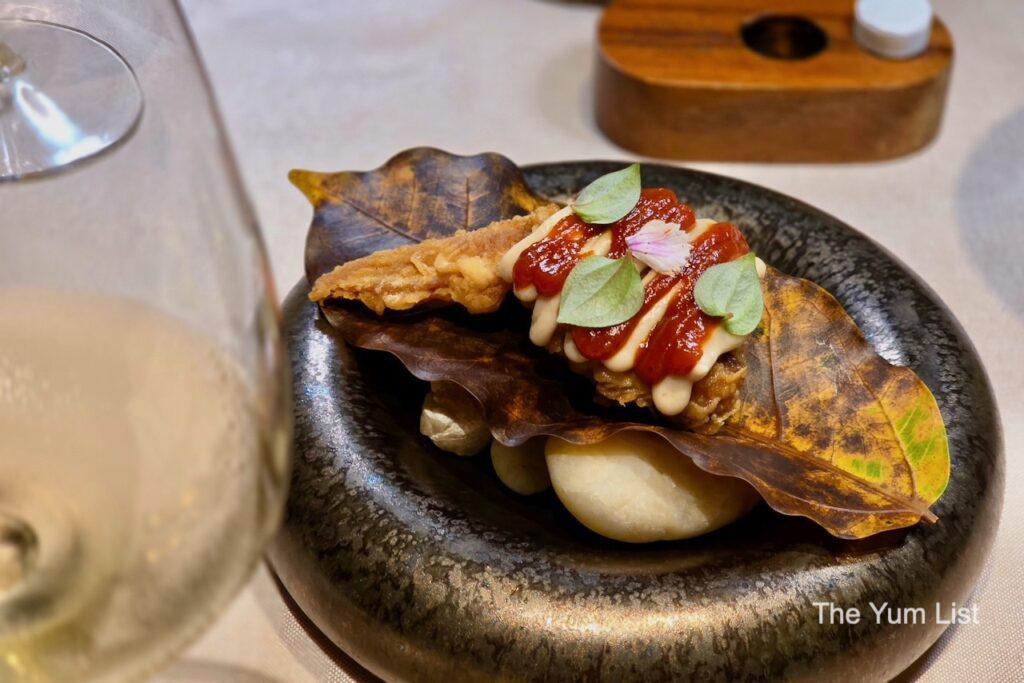
Paired with it is a glass of Peter Dipoli Voglar Sauvignon Dell’Alto Adige, 2020, a crisp Italian white with notes of apricot and lemon, brisk acidity, and a whisper of salinity—just the thing to balance the dish’s richer, sweeter tones.
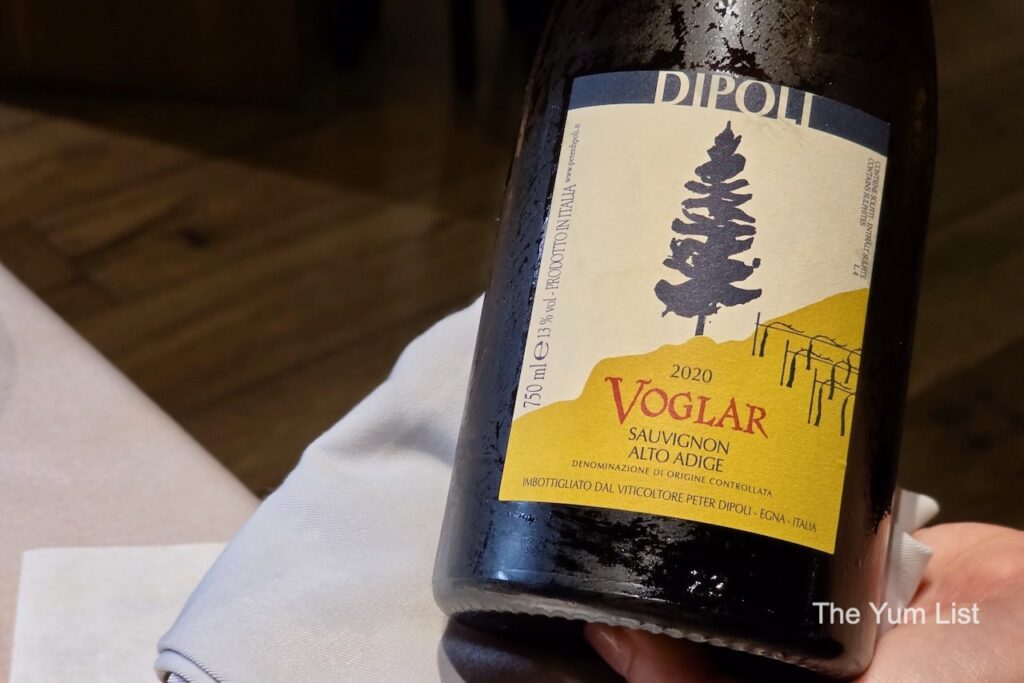
Blue Crab Curry
One of Phuket’s signature delicacies, the Blue Crab Curry is a delightful combination of fresh crab meat salad, crab jumbo lump taco, yellow curry mousse, and invasive mangrove fan palm shoot (Nhor Phor). The crab meat presented in a crab claw is incredibly fresh and tastes slightly of herbs. It’s made even more delicious when we drizzle the yellow curry mousse inside. The small taco contains bitter leaves and palm shoots and disappears in one smooth, tasty bite. Such is the appeal of the yellow curry mousse that we ask for small spoons to keep enjoying it.
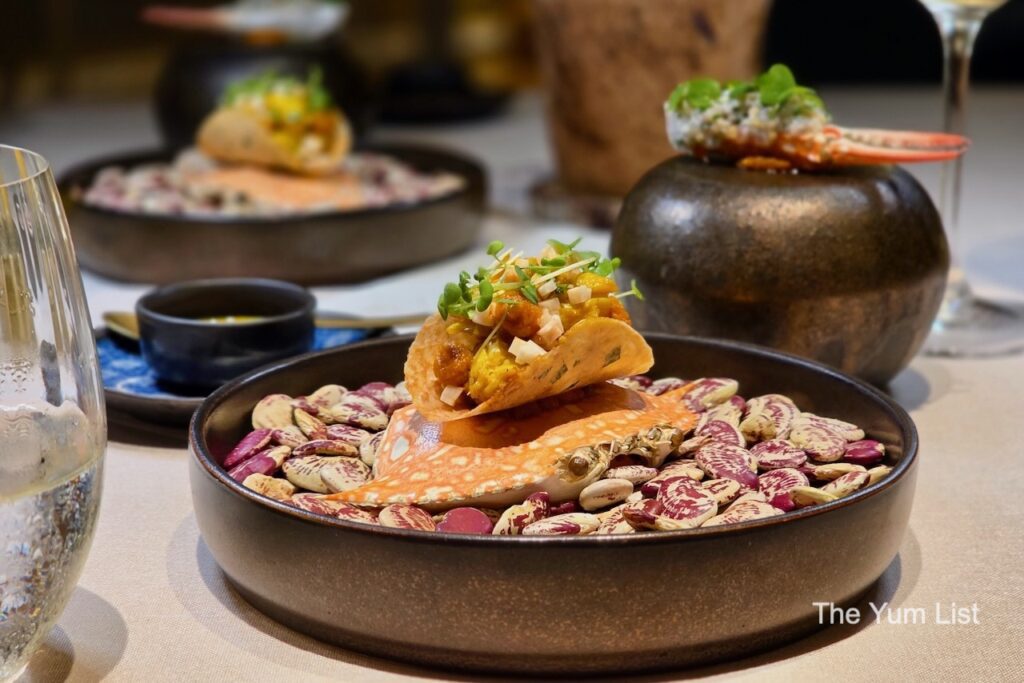
Jor Rang
The Jor Rang features Phattalung river prawn accompanied by southern turmeric curry, pomelo salad, and fermented invasive beehive ginger (nhor pud). The prawn, naturally firm in texture, is served with lemongrass and prawn powder. True to the kitchen’s zero-waste ethos, every part of the crustacean is used. The pomelo salad adds a bright, refreshing contrast, and we find ourselves scooping up every last drop of the richly spiced curry. Small leaves of nhor pud offer a cleansing finish, balancing the dish’s intensity.
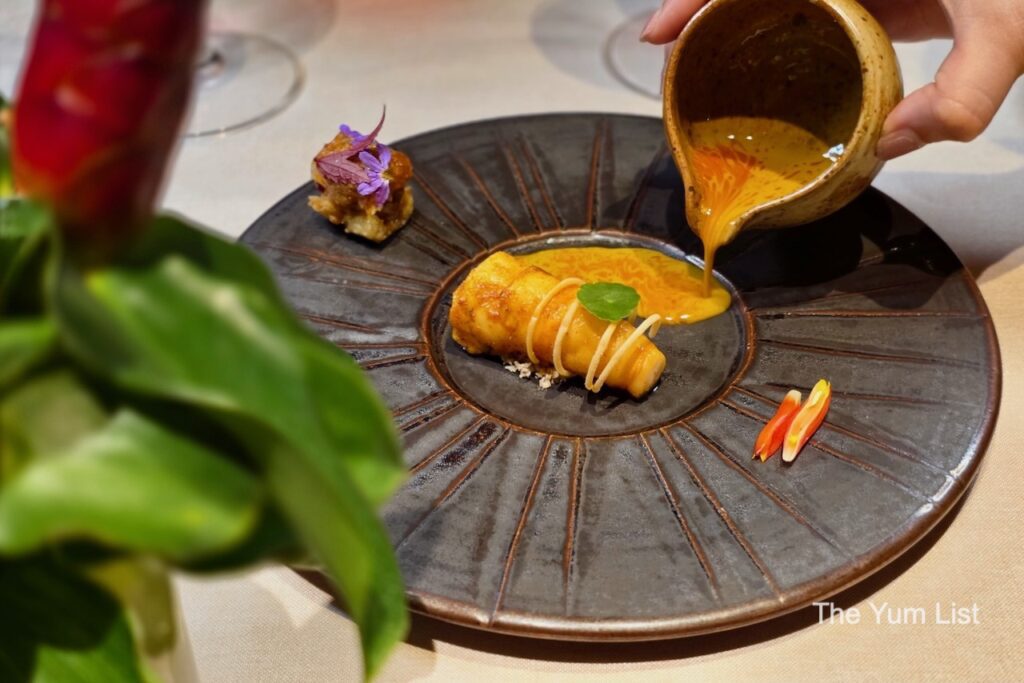
A glass of Anne Sophie Dubois Fleurie L’Alchimiste arrives with notes of black tea and dark berries. Its structure and depth complement the bold, savoury elements of the past two courses, and we savour every sip.
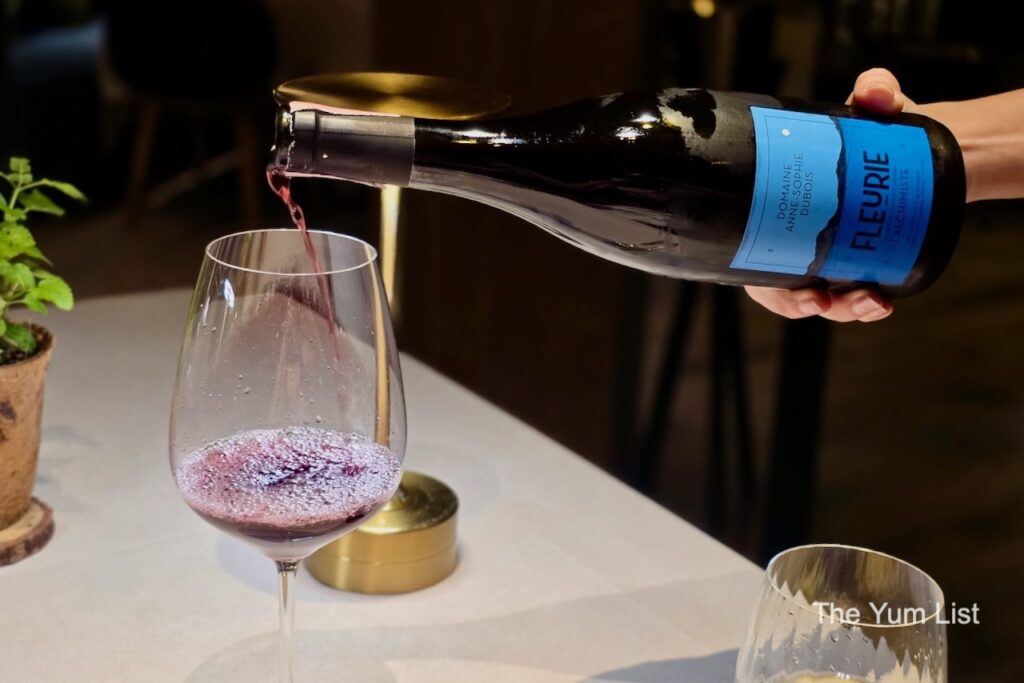
Bak Kut Teh Beef
Brimming with familiar flavours, the Bak Kut Teh beef subverts our expectations and presents beef tongue slow-cooked with homemade cola from coffee waste and vegetable stems. Mushroom puree is used to flavour the bak kut teh’s clear broth, while the leftover onion sheet keeps things crispy. The beef tongue has been slow-cooked for twelve hours to prevent it from becoming overly chewy, and the consommé, a clear soup, is made from the second cut of mushroom. This dish is incredibly savoury and warming.
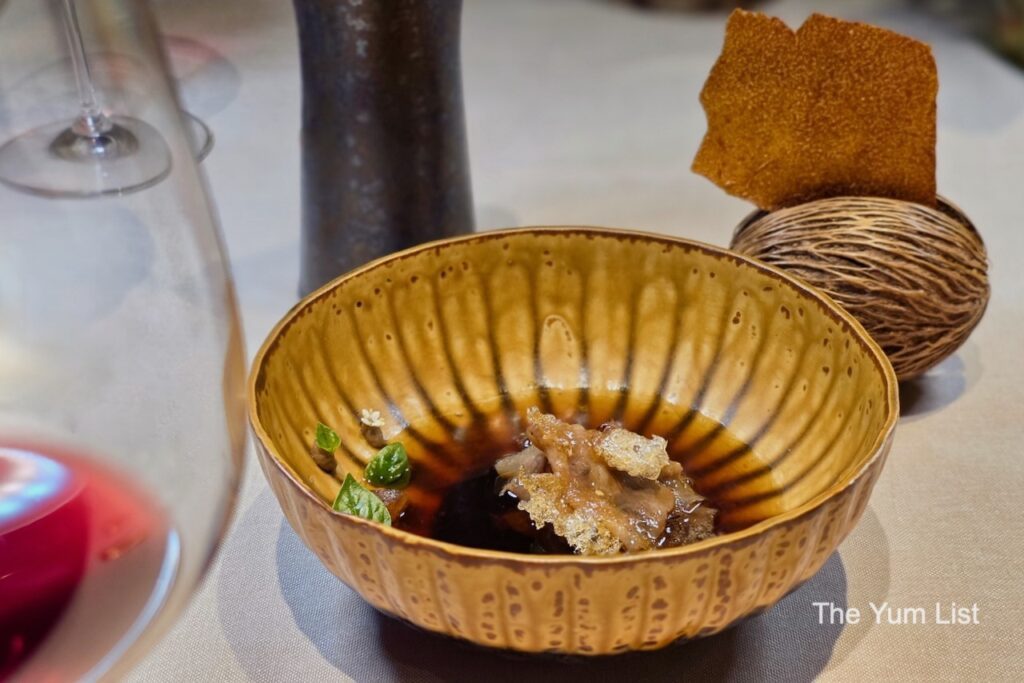
Thepo Curry
The Thepo Curry is artfully composed as a trio: tiger grouper, fish liver mousse, and invasive water hyacinth (pak tob chava). A velvety Southern Thepo sauce is poured into the centre, tying everything together. A dish with over 200 years of history, it highlights tiger grouper native to the deep waters of the Andaman Sea. Lightly seasoned with pepper and mushroom powder, the fish delivers a clean yet robust taste that’s both spicy and fresh. We swirl each bite through the creamy, zesty sauce, savouring the balance. The hyacinth arrives tucked between shards of crisp fish skin, and we finish it in a single, satisfying mouthful.
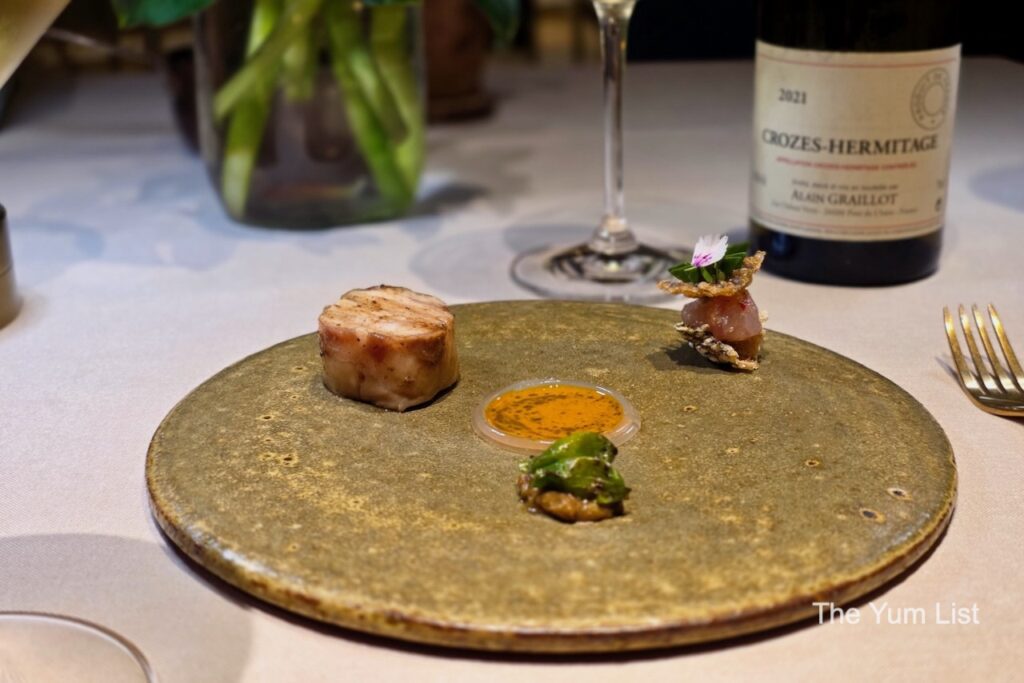
The curry is a perfect match to Domaine Alain Graillot’s Crozes-Hermitage Blanc 2021, marrying Marsanne and Roussanne with finesse, offering stone fruit and citrus notes lifted by a mineral edge. Naturally fermented in large oak barrels, it’s textured yet fresh, thanks to no malolactic fermentation. A Rhône white that’s quietly confident and balanced – Mon’s fave of the wine selections this evening.
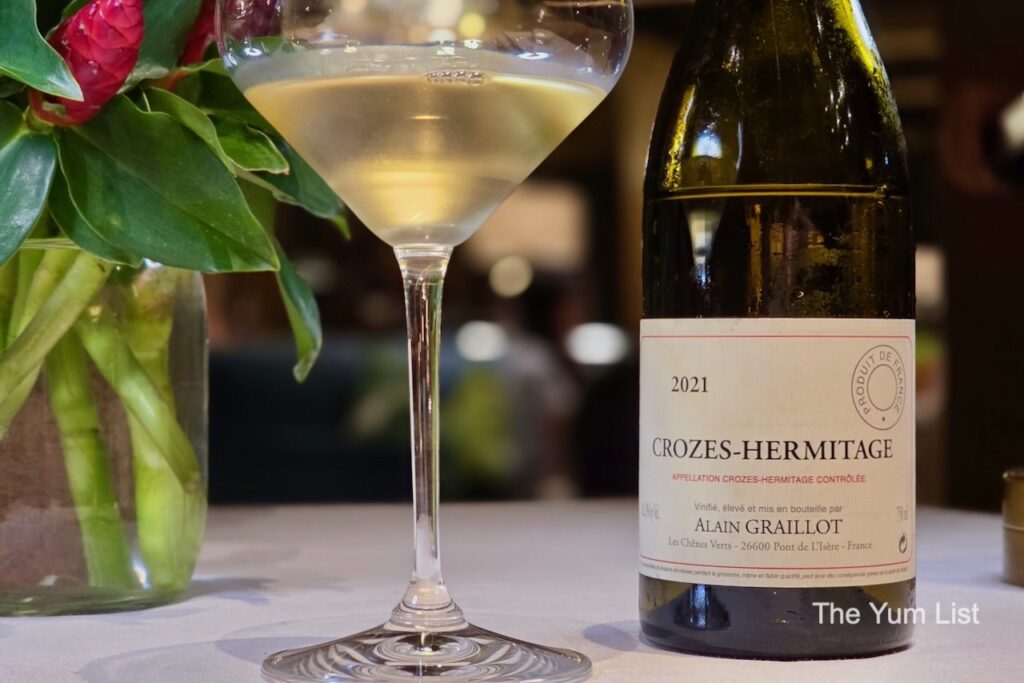
Kanom Jean
Beautifully presented as a ring of fresh ingredients in various shades of green and white encircling a small mound of noodles, the Kanom Jean is both visually and palatably appetising. The noodles are made from invasive black chin tilapia. The sauce poured over them is made from southern roast curry and bonefish powder. The wild vegetables mix easily throughout, and the crispy fish skin mimics the usual accompaniment of fried chicken. What initially appears to be caviar topping the fish turns out to be seaweed. This dish is not too filling, yet we feel utterly satisfied and slurp up every single bite.
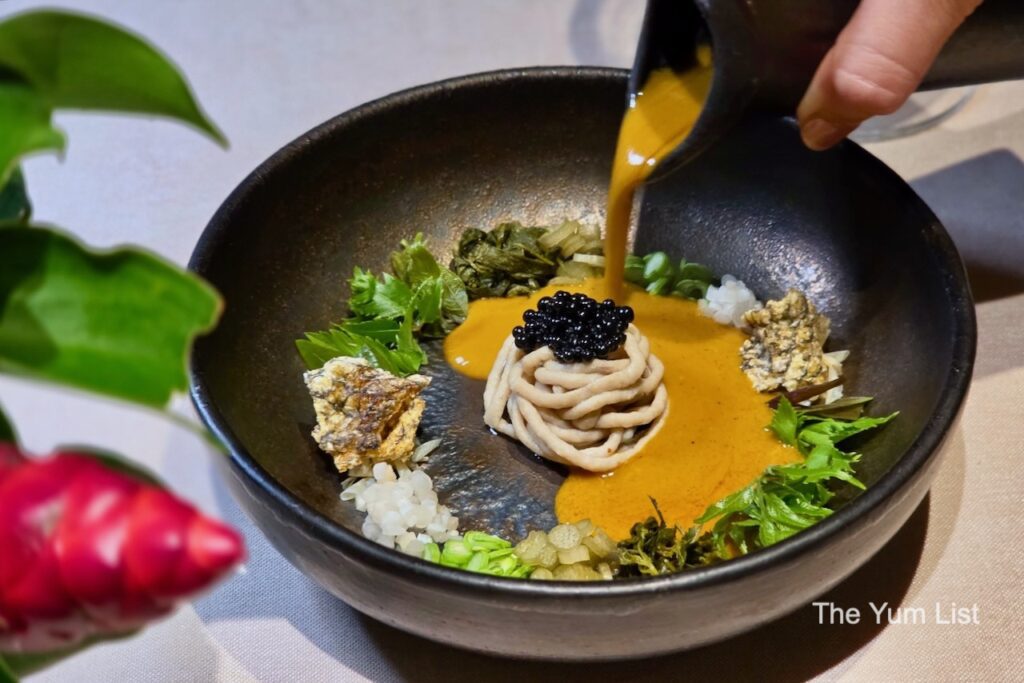
Songkhla Kumquat Tartlet & Waan Sao Long Tea
To cleanse our palates, the Songkhla Kumquat Tartlet is served with halved kumquats resting on a bed of dry ice. One side contains custard and chilli, and the other is orange granita. It’s cold, citrusy, and incredibly refreshing. The Waan Sao Long Tea is slightly sweet from being steeped with pandan leaves, and we don’t waste a drop.

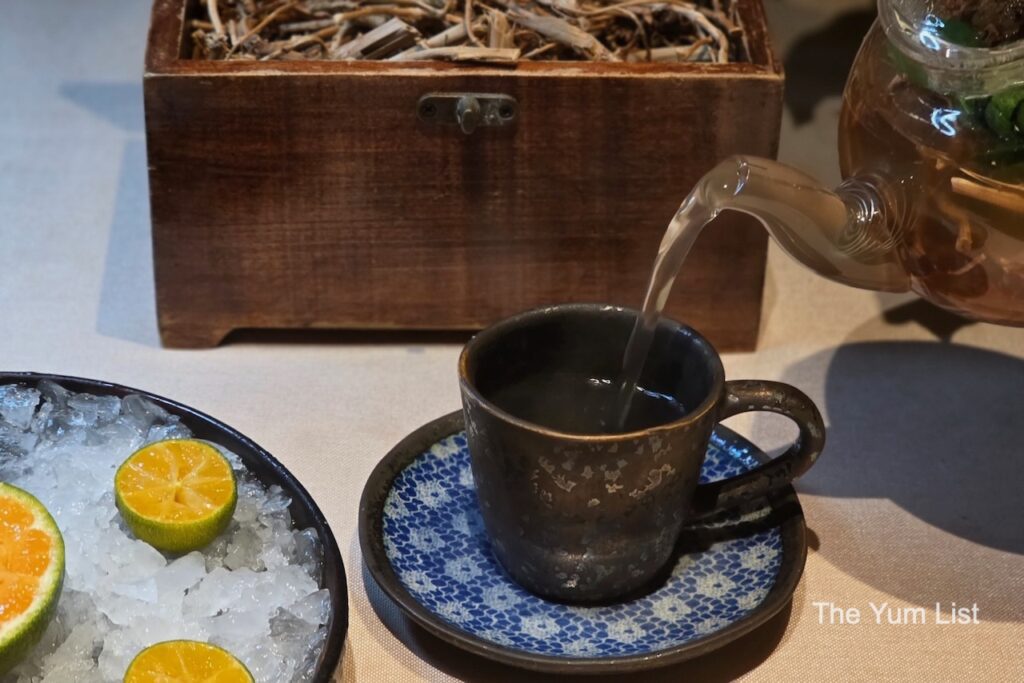
Phuket Lobster Bitter Bean Sauce
When several varieties of local rice are brought to our table, we know we are in for a treat. Black rice (otherwise known as berry rice) from Pattalong in Southern Thailand is tossed with brown rice (or pandan rice) from Sakonnakorn and red rice (tubtim choompara) also from Sakonnakorn to create a fragrant mixture heaped appealingly on our plates. We dig into cuts of Phuket lobster grilled in charcoal, mixed with bitter bean sauce and garnished with fermented invasive Arundo donax (Rapo grass) and crispy lobster crackers. To the side, steaming bowls of soup contain second-cut lobster meat and lobster fat, while local herbs and vegetables are served to help cut the spice. We savour the bitter beans’ nutty flavour and pungent smell, and dip our slices of lobster in the tangy coconut chilli sauce. Every bite highlights the delicately sweet and briny lobster meat.
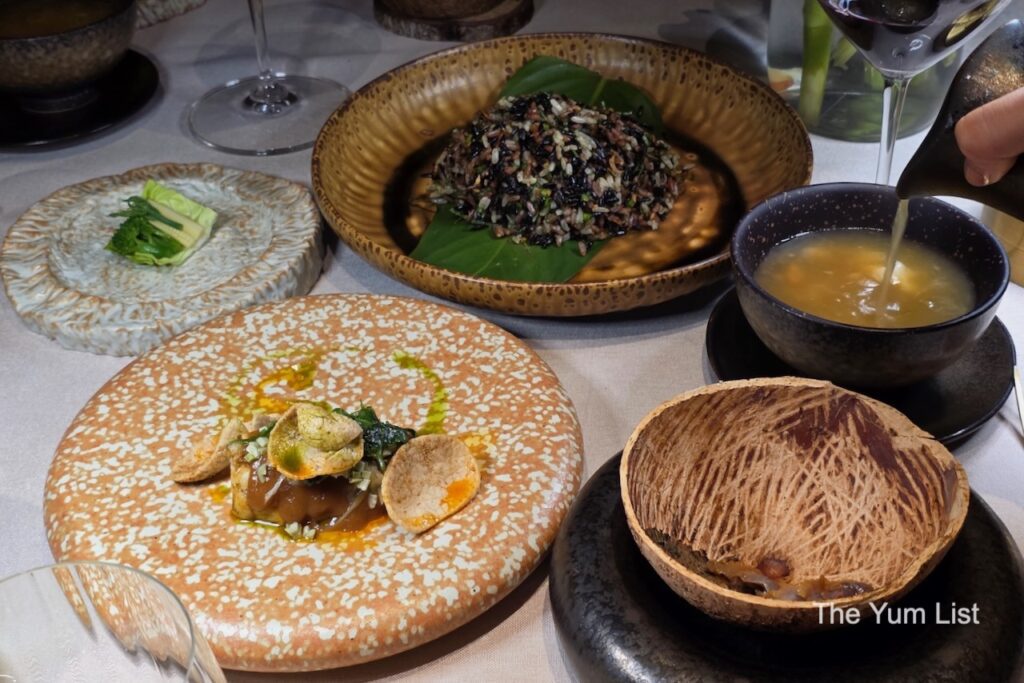
We sip on a glass of Monsoon Valley Cuvee de Siam, 2019, a Thai layered red with notes of blackberry, cherry, coffee and pepper, finishing long with a touch of cacao.
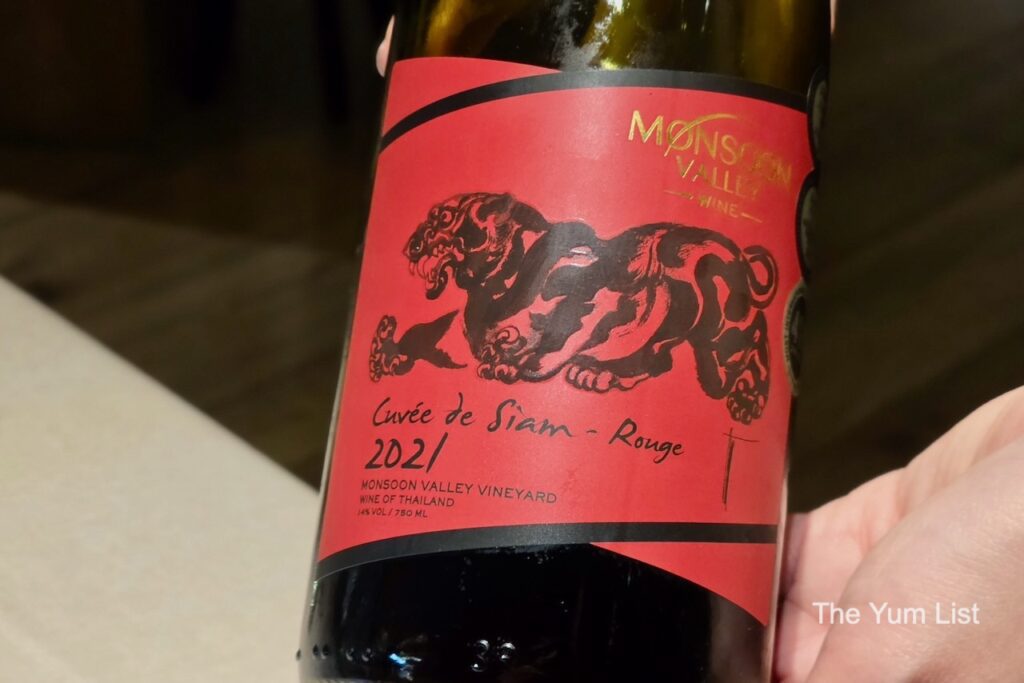
Southern Jungle Fruit
Our meal comes to a cool conclusion with snake fruit ice cream and jungle antidesma foam. Featured throughout are fermented Phang Nga jungle sugar palm (look chok), balacuya (lang kae), palm fruit (lang kub), jungle antidesma fruit (look mao), and annatto fruit (kum ngor). It’s wonderfully tart, sweet, cold, fruity, and crunchy – so many flavours and textures working beautifully in concert.
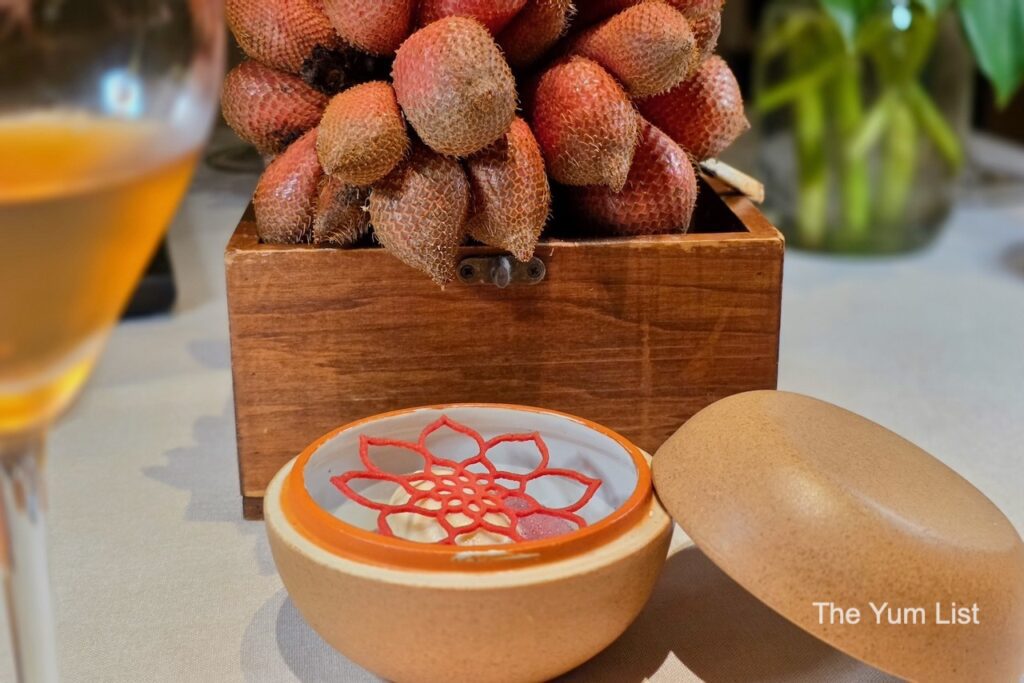
We get a sweet coda with the selection of petite four: Tao Sor cake with cashew nuts, Phuket black pepper cookies (kanom prik), Chinese biscuits (kanom natek), and Crispy Egg (kanom kai krob). The tao sor cake is filled with salted egg yolk, while the kanom prik is peppery and served with coriander. The cookies are deliciously crunchy, and the egg is crispy and creamy.
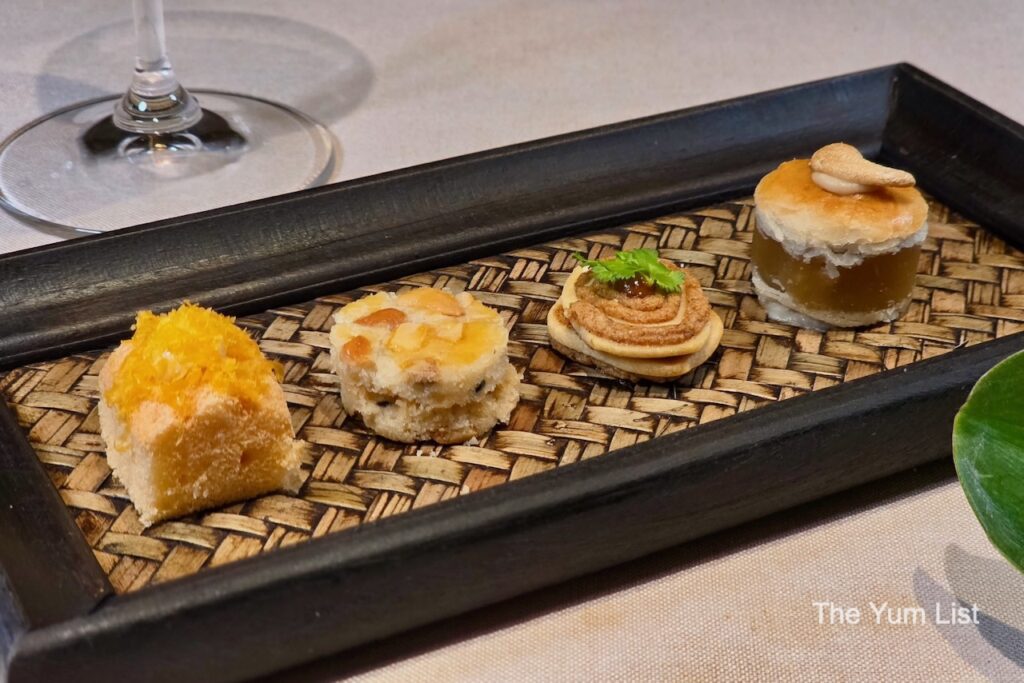
Mon’s eyes lit up as the Barbeito Madeira 10 Year Sercial was poured—a rare finale in this part of the world, and a quietly thrilling one. Dry, nutty, and bracing with citrus and saline tension, it was a sip of Atlantic elegance to end. It was a deeply satisfying punctuation mark to this meal, that would serve equally well as an aperitif. Read Mon’s insights about Madeira wine here.
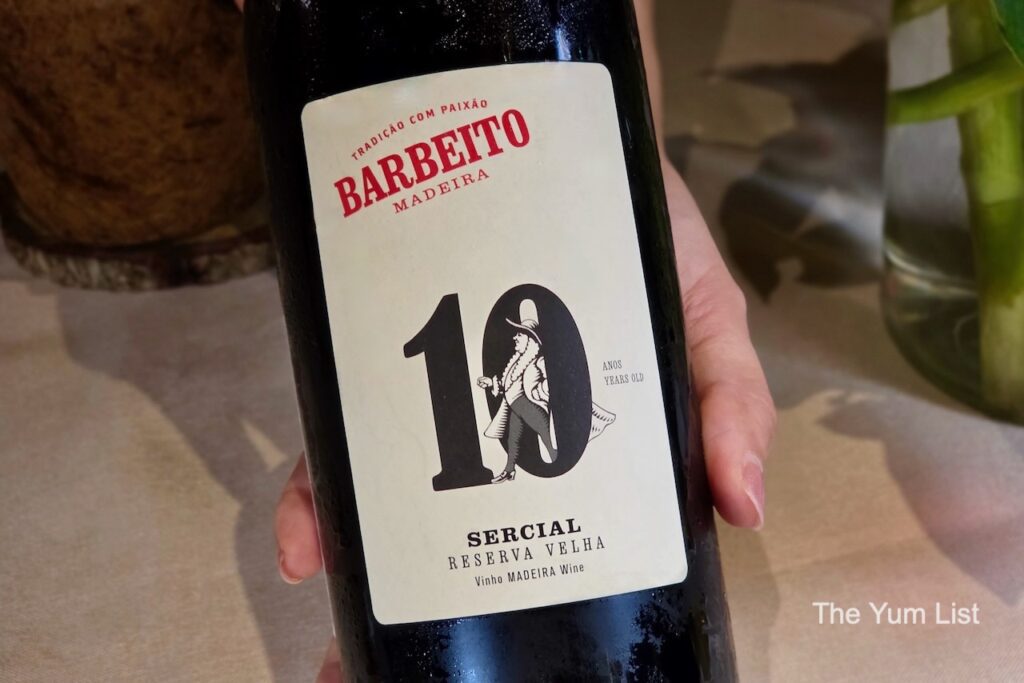
Zero-waste Restaurant Phuket – Jaras Review
Feeling wonderfully content yet slightly wistful that this meal is a once-in-a-lifetime experience, we reluctantly rise from our cosy nook. In a thoughtful gesture, Jessica presents us with Jaras’ parting gifts: a bottle of homemade herbal insect repellent and a jar of tea crafted from meir leaves, an invasive local tree from Songkhla province. Alongside these, we receive a card illustrating Jaras’ cycle of sustainable gastronomy, detailing how every ingredient is locally grown and sourced, prepared and served, then recycled and composted to give back to the community and the farm itself. At Jaras, everything carries a history carefully honoured and a story lovingly told. Tonight, we feel privileged to be part of that story.
Reasons to visit Jaras: exquisite zero-waste restaurant in Phuket with purpose and soul; Inventive menus supporting local communities and prioritising zero-waste practices; wonderfully presented dishes that highlight unique ingredients; fantastic attention to detail; exceptional and heartfelt service.
Zero-waste Restaurant Phuket – Jaras
InterContinental Phuket
333, 333/3, Kamala, Kathu District
Phuket 83150, Thailand
Link to Jaras on Google Maps
+66 76 629 999 @jarasrestaurant
Jaras Opening Hours
Daily: 12 to 9 pm
Find more gourmet travel recommendations for Thailand here, and stay up-to-date on the latest gourmet and travel happenings around Asia via The Yum List on Instagram and The Yum List on Facebook.

